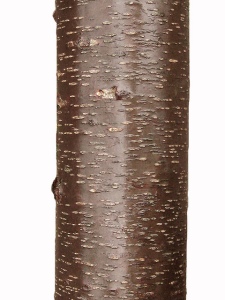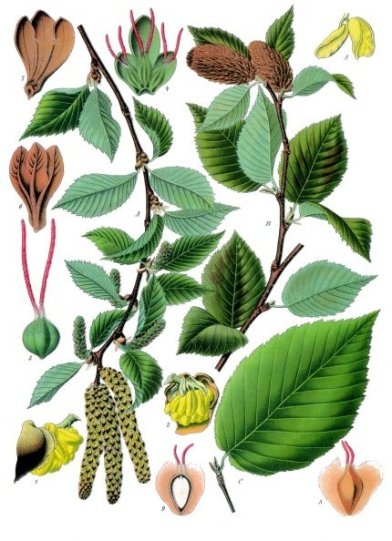A couple weekends ago, I woke outside to a brisk green morning. Peeking out from the depths of my sleeping bag, my face was greeted by cold air and my vision with the white ashes covering the coals of our overnight fire. Beyond that, a few other friends nestled in sleeping bags around the fire. It was the beginning of the second day of the first weekend of the Living Earth Adult Foundations or LEAF program. Later as we all moved around making our preparations for the day, our instructor Hub appeared with a big branch still covered in leaves. Its reddish brown bark was smattered with small horizontal lines, and the leaves were finely, doubly saw-toothed. He snapped a twig and had us all take a sniff—the refreshing wintergreen smell hit me right in the gut. It’s a smell that warms you in the belly. Hub invited us to come and snap twigs and place them in the kettle, placed on the fire for about 15 minutes, to brew up some Sweet Birch tea.
This plant was Sweet B irch, betula lenta, also commonly called black birch, cherry birch, and mahogany birch. There is one other birch in our area, bonus points if you can name it in the comments below (a hint: it’s more in the high mountains.) Birch is a profoundly useful tree: the bark was traditionally used in the making of canoes, baskets, and cups. The tar is called the first superglue as well as an early form of chewing gum. The Creek people used birch to treat tuberculosis; the Catawba boiled the buds with sulfur and made a salve to treat ringworm and sores. The Cherokee treated colds, dysentery, and urinary problems with birch tea and by chewing the young leaves. Today, folks laud the teas diuretic and sedative effects in addition to the soothing quality in topical uses—say, for example, that wily case of poison ivy that won’t respond to usual treatments like calamine, jewelweed, and even tannic acid made from boiling acorns (an anecdote from Tom Brown’s Guide to Wild Edible and Medicinal Plants).
irch, betula lenta, also commonly called black birch, cherry birch, and mahogany birch. There is one other birch in our area, bonus points if you can name it in the comments below (a hint: it’s more in the high mountains.) Birch is a profoundly useful tree: the bark was traditionally used in the making of canoes, baskets, and cups. The tar is called the first superglue as well as an early form of chewing gum. The Creek people used birch to treat tuberculosis; the Catawba boiled the buds with sulfur and made a salve to treat ringworm and sores. The Cherokee treated colds, dysentery, and urinary problems with birch tea and by chewing the young leaves. Today, folks laud the teas diuretic and sedative effects in addition to the soothing quality in topical uses—say, for example, that wily case of poison ivy that won’t respond to usual treatments like calamine, jewelweed, and even tannic acid made from boiling acorns (an anecdote from Tom Brown’s Guide to Wild Edible and Medicinal Plants).
This plant was Sweet B
 irch, betula lenta, also commonly called black birch, cherry birch, and mahogany birch. There is one other birch in our area, bonus points if you can name it in the comments below (a hint: it’s more in the high mountains.) Birch is a profoundly useful tree: the bark was traditionally used in the making of canoes, baskets, and cups. The tar is called the first superglue as well as an early form of chewing gum. The Creek people used birch to treat tuberculosis; the Catawba boiled the buds with sulfur and made a salve to treat ringworm and sores. The Cherokee treated colds, dysentery, and urinary problems with birch tea and by chewing the young leaves. Today, folks laud the teas diuretic and sedative effects in addition to the soothing quality in topical uses—say, for example, that wily case of poison ivy that won’t respond to usual treatments like calamine, jewelweed, and even tannic acid made from boiling acorns (an anecdote from Tom Brown’s Guide to Wild Edible and Medicinal Plants).
irch, betula lenta, also commonly called black birch, cherry birch, and mahogany birch. There is one other birch in our area, bonus points if you can name it in the comments below (a hint: it’s more in the high mountains.) Birch is a profoundly useful tree: the bark was traditionally used in the making of canoes, baskets, and cups. The tar is called the first superglue as well as an early form of chewing gum. The Creek people used birch to treat tuberculosis; the Catawba boiled the buds with sulfur and made a salve to treat ringworm and sores. The Cherokee treated colds, dysentery, and urinary problems with birch tea and by chewing the young leaves. Today, folks laud the teas diuretic and sedative effects in addition to the soothing quality in topical uses—say, for example, that wily case of poison ivy that won’t respond to usual treatments like calamine, jewelweed, and even tannic acid made from boiling acorns (an anecdote from Tom Brown’s Guide to Wild Edible and Medicinal Plants).
In addition to all this, in credibly enough, the inner bark can be boiled like noodles or dried and ground to make a flour. The wood burns reliably, even when wet, and can be used as dye for a fawnlike color. A birch feeds birds with a million seeds per year, and is the exclusive host to birch polypore mushroom, which I’ve read is used in finishing the finest edge in sharpening a knife.
credibly enough, the inner bark can be boiled like noodles or dried and ground to make a flour. The wood burns reliably, even when wet, and can be used as dye for a fawnlike color. A birch feeds birds with a million seeds per year, and is the exclusive host to birch polypore mushroom, which I’ve read is used in finishing the finest edge in sharpening a knife.
 credibly enough, the inner bark can be boiled like noodles or dried and ground to make a flour. The wood burns reliably, even when wet, and can be used as dye for a fawnlike color. A birch feeds birds with a million seeds per year, and is the exclusive host to birch polypore mushroom, which I’ve read is used in finishing the finest edge in sharpening a knife.
credibly enough, the inner bark can be boiled like noodles or dried and ground to make a flour. The wood burns reliably, even when wet, and can be used as dye for a fawnlike color. A birch feeds birds with a million seeds per year, and is the exclusive host to birch polypore mushroom, which I’ve read is used in finishing the finest edge in sharpening a knife.
While our tea brewed, Hub told us of an elder of his who said that sweet birch just lends a feeling of happiness and well-being. On that cool morning, with that sweet taste, we couldn’t argue with that.
I’ll leave you with this recipe for birch beer from Edible Wild Plants: A North American Field Guide to Over 200 Natural Foods by Thomas Elias and Peter Dykeman:
4 gallons birch sap (tapped in spring, 3-4 after the sugar maples)
1 gallon honey
4 quarts fine twigs
1 yeast cakeBoil honey and sap ten minutes and pour over twigs. When cool, strain and add yeast. Cover and ferment one week or until cloudiness begins to settle. Bottle and cap tightly.
No comments:
Post a Comment